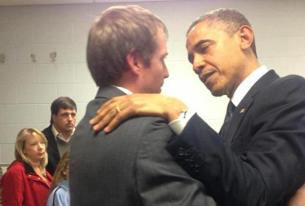Sandy Hook School massacre through expat eyes
(Last updated: 21 August 2013)
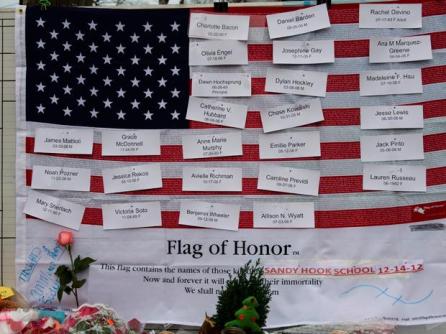
Sandy Hook Elementary School, Newtown, Connecticut: 20 children, 7 adults murdered by a crazed gunman. How much longer will we tolerate the onslaught of gun violence in American schools and public places? (Click on photos to enlarge.)
The whole world mourns
For many of us Americans, Christmas lights celebrating Jesus’ birth will burn a bit brighter this Christmas as we reflect on the Sandy Hook Elementary School tragedy in Newtown, Connecticut. We’ll continue to remember the twenty-seven victims–20 children ages 6 and 7 , the six school teachers and principal and the shooter’s mother–all gunned down within minutes by a single, crazed gunman.
This Christmas there will, no doubt, be family conversations about the horrendous events that unfolded in Newtown, and we will continue to pray for the families who lost their children and loved ones.
The sadness of this heinous act has been felt around the world. Expressions of concern and solidarity with the Newtown families are coming from many nations. Reports on the Sandy Hook Elementary School massacre have appeared in media all over the world. From Australia to England and France, newspapers and TV news programs are reporting the tragedy.
As an expatriate living in Saudi Arabia, I’ve read and heard condolences from several Saudi public officials to the Newtown families. English language dailies The Saudi Gazette and Arab News have reported extensively about the killing of these innocent American school children.
There are now more than 80,000 Saudi students studying in US colleges and universities. I encourage Saudi young people to visit America—to see what is decent about my country—to better understand the prevailing goodness of the American people.
But I’m often asked by moms and dads at our neigborhood mosque, “Do you think it’s really safe for my son (or daughter) to go to an American university?” I try to assure them that all will be okay. I’m hesitant to share with them about my own experiences with guns in the United States.
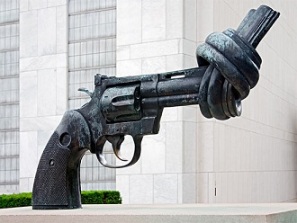
The bronze “Knotted Gun” sculpture by Swedish artist Carl Fredrik Reutersward, outside of the United Nations headquarters in New York. It stands as a constant reminder of gun violence around the world.
My own American gun experiences
Gun violence is not new to America. Somehow during my younger years I managed to be in the wrong place at the wrong time on five different occasions. That’s right. Before I was 25 years old I had guns pointed at me three times—the first time in 1965, while I was a student at Bob Jones Academy in Greenville, South Carolina.
I joined other students on a weekend “extension” to Charlotte, North Carolina, to pass out evangelistic gospel tracts on Charlotte streets. There we witnessed to strangers about our faith in God. I was just 17-years-old when two guys in their early 20s pulled a pistol on me and took my wallet.
The last time was in January, 1975, in Niagara Falls, New York. I was leaving a neighborhood restaurant when two guys approached me and asked for a ride to the Pine Avenue exit on the Robert Moses Parkway. I agreed to give them a ride.
After they got in my car, one of the men pulled a sawed-off shotgun from under his ski jacket. He cocked it and held it to my head, shouting, “Drive!” They directed me down a dark, winding country road. They asked how much gas was in my car. I realized they wanted my car and that I was dispensable.
Although scared, I somehow managed to contain myself. I remember praying silently and repeatedly, “Oh, God, help me!”
As I continued driving down that road with that shotgun being held to my head, there suddenly appeared the lit up entrance of the Martin-Marietta Small Aircraft Factory. There was a guard at the gate. I turned a fast 90-degree left angle, driving directly through the gate without slowing down. I passed the yelling security guard who was trying to flag me down. I brought my car to a stop, switched off the ignition, and threw my keys out the window. The guard was approaching my car with his gun drawn. I told the two thugs they could get out of my car and make a run for it, and I wouldn’t say anything. They got out of my car and ran back through the gate and into a nearby field.
I later found out from police that these two men had just robbed a bank and were on the run.
Even if I had had a hand gun and tried to use it on any one of these occasions, I most likely would have been shot before I could have pointed the gun at any of these criminals.
My saddest gun experience, however, was in September 1972 and involved my roommate Wei Li at Faith Theological Seminary in Philadelphia.
Wei was from Taipei, Taiwan. Two weeks after arriving in the US he got a part-time job at a nearby Chinese restaurant so he could send money back to his wife and two children in Taipei. His second night on the job I received a phone call from the emergency room at Einstein Memorial Hospital. The emergency staff had found my phone number in Wei’s wallet and got in touch with me. I was told to come immediately to the hospital—that Wei had been shot during a robbery.
Wei died before I got to Einstein Memorial.
The Faith Seminary student body and faculty raised money to ship Wei’s body back to his family. We held a memorial service. The incident greatly affected the students and seminary faculty.
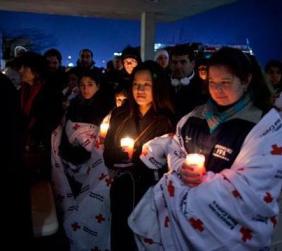
In Connecticut and around the world, candlelight vigils and prayer services were held to remember the Sandy Hook School children and their families.
Reaction to the Newtown massacre
What is new about US gun violence is the mass killings during the past 20 years.
As Americans we’ve become rather numb to an occasional murder. We’ve even become accustomed to the occasional mall or high school shooting–but it’s this massacre of 6 and 7-year-olds that has shaken our nation to its core. There is now a public outcry to respond more effectively to gun violence in our homeland.
It’s being reported that the overwhelming majority of American gun owners are now supporting thorough background checks on anyone purchasing a gun.
May God give us the wisdom and the fortitude to build on this wave of public concern—to do what’s right. Doing nothing is no longer an option.
You see, it isn’t just about Newtown. There have been 70 shootings in US schools since 1995, and the number of shootings in shopping malls, movie theaters, restaurants and even places of worship are known to be numerous. Gun homicides in the US topped 10,000 last year.
The Second Amendment
Now is our time to take a resolute stand against gun violence in the United States. While we will never remove all guns from society, nor do I think we should; however, it is our opportunity to take a look at the Second Amendment and precisely how it should be interpreted in light of modern society.
This amendment to the US Constitution states, “A well regulated militia being necessary to the security of a free state, the right of the people to keep and bear arms shall not be infringed.”
Some have suggested we leave it to the individual states. They ask, why force upon the entire country a law that many don’t want? The Second Amendment, however, is a part of the Constitution. It is federal law and cannot be interpreted arbitrarily by each state. It applies equally to all states and must be interpreted accordingly.
We must acknowledge that times change and there have been incredible advances in the design and manufacturing of firearms. We no longer have the difficult-to-load, flintlock muskets of our forefathers. When authoring the Second Amendment, our Founding Fathers could not possibly have imagined semi-automatic and assault weapons with high-capacity clips (magazines) in the hands of our citizens.
A few years back I joined friends for a late night tour of Washington, DC. One of our stops was at the Jefferson Memorial. It was there I read Thomas Jefferson’s words in panel four of the memorial: “I am not an advocate for frequent changes in laws and constitutions, but laws and institutions must go hand in hand with the progress of the human mind. As that becomes more developed, more enlightened, as new discoveries are made, new truths discovered and manners and opinions change, with the change of circumstances, institutions must advance also to keep pace with the times. We might as well require a man to wear still the coat which fitted him when a boy as civilized society to remain ever under the regimen of their barbarous ancestors.”
For more than 100 years, the Second Amendment’s “right of the people to keep and bear arms” was interpreted as meaning for “a well regulated militia” in defense of the state.
During the past decade, though, the US Supreme Court has given a more liberal interpretation of the amendment that just about any kind of firearm is suitable for personal protection and personal use. The primary US Supreme Court Second Amendment decisions during those years included District of Columbia v. Heller, (2008); and McDonald v. Chicago (2010).
In both Heller and McDonald the U.S. Supreme Court supported the individual rights model, under which the Second Amendment protects the right of American citizens to keep and bear arms in much the same way as the First Amendment protects the right to free speech. It effectively eliminated laws against handguns.
Craig Whitney, former foreign correspondent and editor at the New York Times, has just authored Living with Guns. The book searches for answers while re-examining why the right to bear arms was enshrined in the Bill of Rights and how it has come to be misunderstood today. Whitney looks to colonial times, surveying the degree to which guns were a part of everyday life. Finally, blending history and media reporting, Whitney explores how twentieth-century turmoil and culture war has led to today’s climate of activism, partisanship, and stalemate, in a nation where 60 million gun owners now possess more 300 million guns. I recommend the book to you.
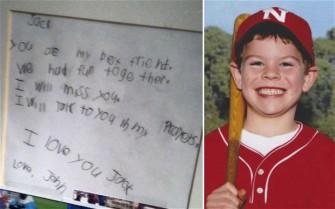
A boy’s heartbreaking letter to six-year-old Sandy Hook victim Jack Pinto has been shared thousands of times on the internet as the United States struggles to come to terms with the atrocity.
Mental illness a factor
In the wake of the Newtown shooting, is the discourse on gun control being sidelined by a focus on mental healthcare? Some think so.
Robert A. Levy, chairman of the Cato Institute, told The New York Times: “To reduce the risk of multi-victim violence, we would be better advised to focus on early detection and treatment of mental illness.”
But there is overwhelming epidemiological evidence that the vast majority of people with psychiatric disorders do not commit violent acts. Only about 4 percent of violence in the United States can be attributed to people with mental illness.
Bold solutions to American gun violence
Many believe semi-automatic weapons, and certainly assault weapons and magazines or clips holding scores of bullets, should be banned all together. Legislation is being prepared by Senator Dianne Feinstein to reinstate an assault weapons ban that expired in 2004.
A Maryland taskforce recommends confiscating guns from individuals considered threats to themselves or others.
A petitions is being circulated to demand that gun manufacturers be held liable for crimes committed by their products.
But, can we do more?
Motor vehicles in the hands of unskilled, untrained drivers can also be deadly. Because of this, we have in all states mandated laws regulating the use of motor vehicles. We are issued title and tag at each point of sale for each vehicle we own. Driver training is required. We’re required to take a written test and pass practical driving test. There are health requirements. Liability insurance is required for each vehicle owned. Then there are renewals and inspections. There are still penalties for operating a vehicle while impaired.
Would any of these requirements be unreasonable for gun owners? Many think not.
Just as driving laws are administered by various state motor vehicle departments, it’s said a national program of gun registration and licensing could be administered by the Bureau of Alcohol, Tobacco and Firearms (ATF). Registration and licensing fees would cover the expenses of administering this expanded federal program.
And what about liability insurance for guns? A retired US navy commander has come up with a novel proposal. Gun owners should be required to have liability insurance on every gun owned, and gun sellers should be required to carry insurance on every gun sold.
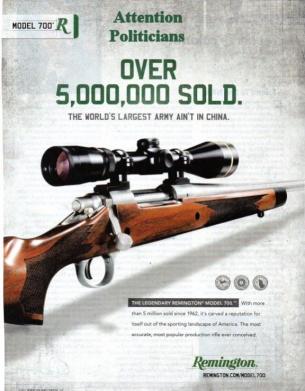
Remington gun manufacturer’s ad promoting sales of the popular Model 700 rifle. Remington boasts this rifle can be fitted with a “double stack 50-round clip (magazine).”
NRA’s role in violence
The National Rifle Association (NRA), America’s most powerful gun lobby, some believe, bears a lot of responsibility for much of the proliferation of guns and violence in American society. The NRA collects dues from more than 4.3 million members, but most of its $150 million budget spent on lobbying Congress and various state legislatures comes from foreign and US arms manufacturers.
Remington, Smith & Wesson and a plethora of profiteering weapons makers pump money into NRA causes. The industry, in my opinion, let’s their desire for enormous profits supercede their concern for the wellbeing of American men, women and children.
The NRA Political Victory Fund (NRA-PCF) provides massive funding to pro-gun politicians’ campaigns while declaring all-out war on any politician who doesn’t completely agree with NRA positions.
Over the years, the NRA has bullied state legislators and US senators and representatives into weakening gun restrictions. Already mentioned, was the NRA’s legal support in the US Supreme Court’s decisions siding with Heller and McDonald.
The NRA has consistently funded political campaigns such as that of 2012 Iowan Republican congressional candidate Ben Lange. “Ben Lange supports the U.S. Supreme Court rulings in District of Columbia v. Heller and McDonald v. City of Chicago, which held that the Second Amendment guarantees a fundamental, individual Right to Keep and Bear Arms for law-abiding citizens in Iowa and everywhere in America.” Lange lost.
The NRA spent nearly $19 million in the last federal election cycle. This money is not just spent to defeat Democrats but also to beat Republicans who don’t toe the line.
Tennessee Republican state lawmaker Debra Maggart was a lifetime member of the National Rifle Association. She had an A+ rating with the group and even supported allowing guns in bars. But when Maggart decided not to back a bill allowing guns in cars – even on properties where the owners did not want guns, the NRA turned against her. The group did everything in its power to ensure her election defeat by alledging Maggart “supports President Obama.” They succeeded.
The budget of the Bureau of Alcohol, Tobacco and Firearms has been deliberately decimated by NRA lobbyists and their supportive lawmakers on Capitol Hill. Operating now with only a part-time director, ATF is understaffed and has absolutely no ability to track the massive flood of firearms being sold across America.
In an editorial on June 27, 2011, the Washington Post stated, “Concerned to the point of paranoia about the erosion of the constitutional right to keep and bear arms, the National Rifle Association and far too many lawmakers have fought against virtually every proposal to empower the bureau to better track and crack down on illegal firearms.” The editorial further pointed out that NRA pressure on Congress had kept the ATF “rudderless for the past six years by blocking confirmation of new directors.”
There are now more than 310 million privately owned guns in America—that’s more than one for every man, woman and child. We have many more guns per capita than any other developed nation, and these guns have not made America safer. To the contrary, we have many more violent gun deaths than any other developed nation.
The NRA is last week promised “meaningful contributions” in the current national discussion. But don’t hold your breath in hopes of any NRA substantive cooperation in curtailing American gun violence. It is the belief of many that the NRA is a master of deceit and is proven in the art of psychological warfare, constantly jockeying and repositioning itself with the ebb and flow of changing public opinion–using scare tactics to confuse and frighten people.
On December 22, 2012, Wayne LaPierre, the executive vice president of the gun rights group, showed no willingness to act civily. Instead, LaPierre called for a “plan of absolute protection” which includes a call for more guns–arming teachers and putting “armed police officers” in every single school across America.
New York mayor Michael Bloomberg called LaPierre’s performance a “shameful invasion of the crisis.”
Having armed guards in our school would offer little help. There was an armed guard on duty at Columbine High School, 1999, when two students went on a rampage killing classmates and staff. Still there were 17 dead and 21 students injured, some seriously. And, remember the military chaplain that started firing at soldiers and army personnel on the Fort Hood base. He was on a secure military facility. That lone gunman managed to leave behind 43 casualties and 13 dead.
Now is the time for the NRA to change course, recognizing our nation’s critical state of affairs, working with the President and Congress to implement new regulations and restrictions on American gun use.

Chicago mayor Rahm Emanuel and other local officials demanding stronger gun regulations at a news conference last week
Big-city mayors remind us
Throughout the US, city mayors are asking for help in combatting gun violence. They want us to remember that gun violence is not simply about suburban massacres, as alarming as they are, but about daily terror in America’s cities.
In Camden, New Jersey, a city that has already suffered 65 violent deaths in 2012, surpassing the previous record of 58 violent deaths set in 1995, 50 people turned out. Some turned up bearing white crosses, to mourn a homeless woman known affectionately as the “cat lady” who was stabbed to death (50 of the deaths so far this year resulted from gunshot wounds.)
In Philadelphia, on the same Sunday, city leaders came together at a roundtable to discuss their own epidemic of gun violence. The year-to-date total of homicides is 322. Last year, 324 were killed. Of those victims, 154 were 25 or younger. A councilman at the roundtable asked, “How come as a city we’re not in an outrage? How come we’re not approaching this from a crisis standpoint?”
CNN reports that the concerns go far beyond Philadelphia. In the week following the Newtown massacre, there were at least a dozen gun homicides in Chicago, Detroit, Baltimore and St. Louis alone. In a year of highly publicized mass shootings, inner-city neighborhoods that are plagued by gun violence have continued to be neglected and ignored.
According to the Centers for Disease Control and Prevention, large metropolitan areas account for more than two-thirds of deaths by gun violence each year, with inner cities most affected. The majority of the victims are young, ranging in age from their early teens to mid-20s, and black.
Unfortunately, paranoid extremists among us, in usual fashion, are rushing off to buy more guns and ammo while shouting their enduring mantra “Obama is coming for our guns!”
Bullet Blocker and other US merchandisers are busy hawking bulletproof vests and backpacks for America’s elementary school children. And some are supporting the NRA demand that more guns is the answer–that American school teachers must be armed and calling for armed security guards in every school.
Senseless acts of rage persist
On August 20, 2013, three teenagers, 17, 16 and 15, in Duncan, Oklahoma, intentionally gun down an Australian college student just “for the fun of it”!
On August 21, 2013, gunman in Atlanta area school, surrenders after hero school lady talk him into giving up his AK-47.
“We the people”
What happens now depends on “we the people.” Will horrific gun violence in America be accepted as the new normal? Or, will “we the people” determine a new course for our nation—one that seeks to minimize gun violence, making mass killings and daily homicides in the US rare and uncommon.
In closing, I want to put a human face on the Newtown tragedy—that of 6-year-old Ana Marguez-Greene. Ana’s dad posted a brief one-minute video on YouTube in Ana’s memory. I’ve included it below. Watch as Ana sings, and then enlist yourself in the change that is needed in our nation and the world.
Information sources: CNN, The Philadelphia Inquirer, The Washington Post, The New York Times, Arab News, The Saudi Gazette, International Herald Tribune, The Chicago Tribune, ABC News, YouTube.com, The US Centers for Disease Control, Associated Press, Office of Senator Dianne Feinstein.
December 21, 2012 Posted by Samuel Shropshire | Uncategorized | Abrahamic faiths, Alcohol Tabacco & Firearms, Ana Marguez-Greene, Annapolis Maryland, assault weapons, ATF, Baltimore, Barack Obama, Camden, Chicago, Come Thou Almighty King, Connecticut, Craig Whitney, elementary school, expat, gun control, gun manufacturer, gun violence, interfaith, Jeddah, Living With Guns, Maryland, massacre, mental illness, Michael Bloomberg, National Rifle Association, Newtown, NRA, Philadephia, Rahm Emanuel, Remington, Sam Shropshire, Samuel Shropshire, Sandy Hook, Saudi Arabia, Second Amendment, semi-automatic guns, Thomas Jefferson, Wayne LaPierre | 13 Comments
About Sam’s Blog
 Here we will chronicle Sam’s life, travels and perspectives on the Middle East and other parts of the world. Sam is seeking to build bridges of understanding and cooperation between the Abrahamic faiths.
Here we will chronicle Sam’s life, travels and perspectives on the Middle East and other parts of the world. Sam is seeking to build bridges of understanding and cooperation between the Abrahamic faiths.
“One thing is certain,” Sam says. “No one will gain from a new ‘cold war’ that seeks to target Muslims as the new enemy. We Muslims, Christians and Jews can find a better way!”
Sam believes that together we can work towards a brighter future; one which provides all men, women and children an opportunity to live in peace; enjoying the blessings of freedom, dignity and hope.
![]()
-
Recent Posts
Pages
-
Join 6,615 other subscribers
Meta
-
Archives
- November 2018 (1)
- June 2018 (1)
- December 2016 (1)
- November 2016 (1)
- June 2016 (1)
- May 2016 (1)
- July 2015 (1)
- March 2015 (2)
- February 2015 (1)
- October 2014 (3)
- September 2014 (2)
- August 2014 (1)
-
Categories
-
RSS
Entries RSS
Comments RSS
